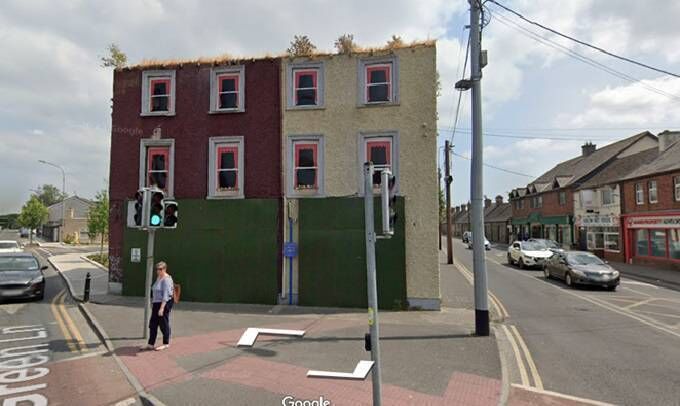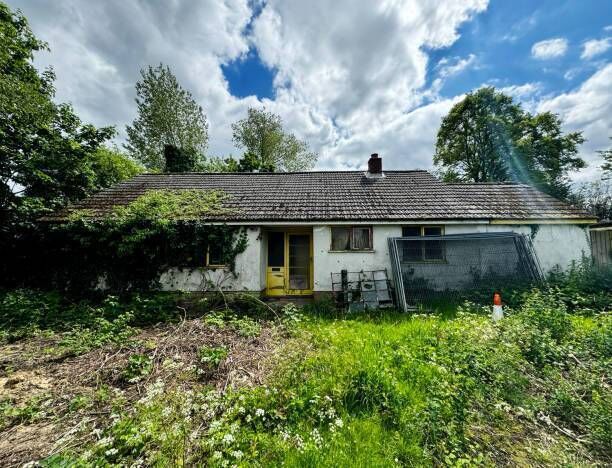Minister's 'war' on vacancy and dereliction is missing timeframe and crucial policy measures

Taoiseach Micheál Martin, Tánaiste Simon Harris, housing minister James Browne, and minister of state John Cummins at the launch of a new Government action plan on housing and homelessness last week. Picture: Leah Farrell / RollingNews.ie
After five years of campaigning to end the blight of dereliction, last month, we finally felt like the #DerelictIreland movement was winning, with the new derelict property tax, housing minister James Browne’s recently declared war on dereliction and the impending housing plan.
As such, we expected the Government’s new housing plan would reflect the dominant sentiment in the recent Oireachtas housing committee meeting on vacancy and dereliction, where we presented 15 policy solutions. As summarised by chairperson Séamus McGrath: “I think we all agree that we need to do an awful lot more about both vacancy and dereliction.”
Our optimism peaked when we saw the housing plan was “working towards ending dereliction and vacancy”, the first time we’ve seen such a commitment by an Irish Government.
And in fairness, the plan does contain all the right sound bites, correctly calling out vacancy and dereliction as a blight on local communities and the economy, and “a missed opportunity to provide new homes in a sustainable manner”.

Unfortunately, after all the optimism, the new housing plan fails miserably to instil confidence this epidemic will be eradicated. Despite taking a year to write, the plan lacks details, appropriate timeframes, and fails to include critical policy measures.
The target of creating 300,000 homes by 2030 will see 8.3% of these coming from derelict and vacant homes; 20,000 through the vacant property refurbishment grant; and 5,000 through compulsory purchase orders.
This is a significant increase of the vacant property refurbishment grant’s original target of 2,000 grants by 2025 and demonstrates the Government initially underestimated the potential and demand for creating homes from vacant and derelict properties.
Likewise, compulsory purchase orders' ambitions are double that of the previous plan’s target “to acquire at least 2,500 vacant units by 2026”.
However, when you consider the amount of vacant (163,433), derelict homes (20,413) and empty commercial buildings (30,246) in the country, and the number of people in desperate need of their own home, these targets lack ambition and urgency.
Since vacancy is the gateway to dereliction, you would expect an ambitious plan to ensure this pipeline is stopped. Yet the Government is continuing with the failed vacant homes tax, whose penalty rate is far too low (0.7% compared to a typical rate of 5% seen in other countries).

Likewise, the number of homes paying the vacant homes tax is dismal — the 2,300 homes liable represents a mere 1.5% to 2.9% of the vacant homes identified by Census and GeoDirectory, or just 3.5% of the 65,000 homes empty for two years, according to the ESB.
Given the failure of the vacant homes tax, it is unclear why the Government is also making the new derelict properties tax self-assessed. This, combined with proposed delays in creating the new dereliction registry to at least 2027, and the lack of an implementation date for the tax, is extremely worrying.
If the Government believes the vacant homes tax is an accurate record of the vacant homes suitable for reuse, are they expecting a massive influx of additional vacant homes to apply for the 20,000 vacant property refurbishment grants.
Or is it a silent acknowledgement its policies could incentivise some owners to purposely leave homes empty for free money, as there is little chance of owners being subject to the vacant homes tax.
Owners of derelict homes can also be exempt from paying the local property tax, while also having a very low chance of being invoiced for the derelict site levy.
Because even the Government acknowledges the 2,140 officially registered derelict properties “does not adequately reflect the scale of dereliction in our urban and rural areas”.
And with only 1,300 CPOs since the last housing plan, we urgently need additional deterrents to end vacancy and dereliction. While owners of derelict homes could pay no taxes on their properties, they have access to more than €100,000 of grants, through the vacant property refurbishment grant and SEAI energy efficiency grants.
The new housing plan also omits to mention the many empty and derelict properties owned by State bodies such as HSE and OPW, something that was deemed a priority in the last plan. Will these buildings be left to decay further while these State bodies rent premises from private landlords? And likewise ghost estates seem to have fallen off the radar.
The plans tackling vacant council homes (voids) are also underwhelming. While they mention new funding and incentives to reward councils for quicker re-lets and lower vacancy rates, the plan lacks detail on how these incentives will work.
And when you consider the last plan’s failure to achieve its objective for planned maintenance programmes for council homes by the first three months of 2024, it doesn’t give you much hope.
What is particularly disappointing is the lack of reference to direct employment of maintenance staff within councils to deal with voids.
At the aforementioned Oireachtas committee meeting, Longford County Council staff estimated direct employment resulted in a 25% financial savings, quicker turnaround time and “also a more efficient system because the council can get the work done when it wants it done”.
We cannot write a piece on vacancy and dereliction without reflecting on the ongoing data saga. Revenue already has a vacancy registry and it will have a new dereliction registry by 2027.
But these registries are in addition to the many other separate datasets on vacancy and dereliction, all counting different things in different ways. When will we finally create one dataset on our buildings in Ireland, which includes all relevant data (ownership, usage, condition, age etc) and which should form the bases of the generous grants?
Finally, in terms of critical policy measures, it is incomprehensible and bordering on reckless the Government has ignored other “use it or lose it” policies that would be transformative, particularly compulsory sales for derelict homes and compulsory rental for vacant homes.
In conclusion, we do not believe the housing plan goes far enough to end the vacancy and dereliction epidemic. We needed to move forward with leaps and bounds but instead we got business as usual with a few tweaks.
These are bad policy decisions that will continue to destroy lives while empty homes lie everywhere. The Government must do better, for those on the streets, for the 5,238 children in emergency accommodation, and for everyone struggling to get a home tonight.
We continue to live with dóchas that the Government will listen and will take the required action to end dereliction and long-term vacancy.
- Jude Sherry and Dr Frank O’Connor are the co-instigators of the #DerelictIreland movement and co-founders of anois and FFUD
















